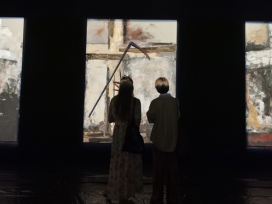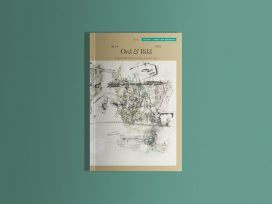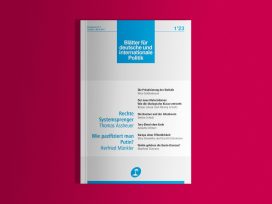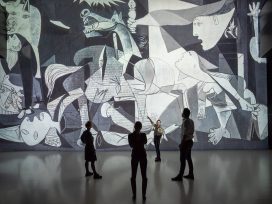An analyst commenting about the previous week’s stock market prices must, in some cases, disclose his or her own personal portfolio, for example by adding a statement such as “the author owns shares in Company X”. The obligation to reveal potential conflicts of interest is a feature of regulated financial markets.
But an historian, professional or amateur, commenting on the past of an entire country or even continent, on the victims of war or dictatorships, is subject to no such rule. The right to express opinion – regardless of the person expressing it or conflicts of interest that may arise – is a cornerstone of free speech, a feature of liberal democratic societies.
Still, this seems odd. After all, public interpretations of history can, in some circumstances, have a vastly greater influence on their subject than a weekly commentary on share values. In a sense, our collective past is formed by the public exchange of images; and the level of personal bias in historical retrospection is generally higher than in weekly roundups of developments on the FTSE.
Any personal opinion about history is linked to a personal portfolio, a unique form of bias that we can never escape; although of course we can, in an attempt to achieve objectivity and distance, reflect on it and challenge it. Our personal portfolio – our cultural, social and economic capital – goes hand-in-hand with certain interpretations of history, promotes loyalty towards certain milieus of remembrance, creates mistrust or hatred of others. The portfolio itself is a product of history, founded on the victories and defeats of a certain social class, an ethnic group, a social milieu, on losses suffered and gains made over the course of wars and dictatorships; it is interwoven with our family inheritance, with our ancestors’ histories of suffering or success, in the space between camp and politburo. Our view of history is idealised and tarnished by an inheritance that has an emotional impact on us and makes emotional demands of us. But the sources of this personal bias are not, in general, disclosed.
This may be just as well in an environment in which a factual debate can, in an instant, mutate into a disqualification of our opponent on the basis of his or her membership of one or other camp of family history – for example in the bipolar model of communist versus nationalist, an inverted relic of the Yugoslav era. But in productive contexts, disclosing personal portfolios might help to break down fossilised patterns of thought. An insight into the real lifeworlds and biographies of a family narrative refutes such polarised phantasms. It reveals diverse inventories of memory, and in so doing promotes inter-memorial dialogue. It bears witness to personal bias and the unavoidability of conflicts of interest, but also the possibility of their productive cultivation via narrative disclosure.
2
The author is the owner of a dilapidated summer cottage on a small island in the Adriatic. This inheritance from a distant relative included the accompanying goods and chattels – the collected clutter of several generations. We did not dispose of this junk immediately, but inspected and assessed it, with a loving eye for detail: a fatal mistake. Inspection and assessment turned the “junk” into traces of life, relics bearing witness to an eventful family history that could no longer be “disposed of”. The piece of land and the structure that occupied it became a place of remembrance that resists demolition and hampers renovation.
In a sense we inherited the hoarding syndrome of aunt S. (1918-1996), the last inhabitant of the house, albeit not to the same pathological degree. For S., not a single woodworm-infested piece of furniture could be disposed of, not a kitchen utensil replaced, not a document in the art nouveau bureau touched. But it was these documents that finally revealed the reason for her hoarding. Expropriation Decree No. 3723/45, dated 8.1.1946, lists familiar objects: furniture (“cloth armchairs, 3 pieces at 150.-“), crockery (“bowl, porcelain, with lid, 1 piece, 90.-“), clothes, (“women’s hats, with boxes, 12 pieces at 20.-“, the toys (“Children’s iron, 1 piece, 10.-“), utensils (“bread basket, basketweave, 1 piece, 10.-“), books (“Skiing, with a postscript by the Ustasha Youth”). Of the 335 items listed, only six are included in the final Court Decree No. 3723/45-4 dated 26.1.1946: 1) three men’s nightshirts, 2) light summer coat, 3) short underpants, 4) razor strop, 5) walking stick, 6) old shoes (men’s). The changes were due to the efforts of great aunt M. (1891-1978): the only items eventually expropriated were those that had irrefutably belonged to her husband, great uncle V. (1889-1974), enemy of the people, sentenced to death but released a number of years later. Aunt S., their daughter, developed a pathological attachment to the objects that had been saved and a paranoid fear of the socialist state.
The family’s post-war history, from the daughter’s emigration to find work to the parents’ dank existence in a ground-floor apartment, is a typical example of Yugoslav de-nazification. The art nouveau bureau gives it away: during the Croatian Axis-controlled puppet state, from 1941 to 1945, the family had lived in a state-owned villa (the previous owners had probably been dispossessed) in the poshest part of Zagreb. V., a doctor of law, did not have a long commute to work: down the hill, up the other side, and there he was in the heartland of power, a ministry and government official in economics. After Italy capitulated, he became a regional administrator in Zadar, in Dalmatia. Is it true that his early dismissal was due to his political unreliability? How did he make it into the centre of power in the first place, Great-Uncle V., notorious contrarian as he was? And how was his desire for advancement related to his chronic lack of funds? A social climber from an impoverished background, in a “mixed marriage” with a member of the bourgeoisie. The education of their only daughter, S., from the Viennese boarding school “Our Lady of Sion” to the “Facoltà di giurisprudenza” in Rome. Living beyond their means, permanently in debt, then the world war. And yet it brought a sigh of relief, with the hope of a decent salary in the upper echelons of the dictatorship.
The beneficiaries of war and its victims can be related. Great uncle V. had been in his post in Dalmatia for a month when his nine-year-old great-nephew was blinded playing with an Axis shell. Initially the family hoped that medical help would be available: the well-placed uncle would surely be able to arrange something. The family moved to the mainland, but their journey to the great-uncle was prevented by air raids. One of the Luftwaffe’s gunners serving on the eastern Adriatic coast at the time was J. (1921-1986), later a world-famous artist and from 1961 on professor at the Kunstakademie in Düsseldorf. H., a graduate of the Düsseldorf Werkkunstschule, might theoretically have become his student, but instead she married, in the same year, the now adult M., and so came to Yugoslavia. Seven years later H. and M. became my parents. Did Joseph Beuys, in his airplane, shoot at my future father in December 1943, as my father travelled to Great-Uncle V. to be saved?
The author of these lines likes to think that his personal portfolio is a good basis for examining collective images of history. The portfolio includes the experience of growing up as an outsider in multiple senses: as the child of a so-called foreigner and a so-called war invalid, in the social mishmash of a Zagreb post-war tower block, with a high proportion of army families. The taunts incurred (“Sva-bo, Sva-bo!”), the horrendous prejudices and the haughty defensiveness of the family contributed to a fundamental mistrust of collective truths, from the deadly neighbourhood gossip to the deadly phrasemaking of the political bigwigs in south-Slavic Absurdistan. The portfolio also includes a neurotic sensibility for the arrogance of the healthy, the powerful and those accustomed to success; and for the suffering of the damaged and the powerless. Not least, it includes the colourful chapter of a family history almost lost in silence and forgetting. Without personally-experienced trauma, history remains distant enough to hold emotional involvement at bay; but the closely-woven traces of suffering and entanglement mean it is sufficiently close to encourage enquiry and the temptations of sympathy.
3
What has become of Yugoslavia over the last two decades, in the rear-view mirror of collective memory? This is answered most straightforwardly by looking at the mnemonic extremists and distilling their own mutual stereotypes into a typology of post-socialist memorial culture.
Thus the post-Yugoslavian nationalist emerges as the dominant type. His chauvinistic worldview has sometimes been passed down from earlier generations (especially relations of the extremist émigrés who hurried back to the country after 1990). But for the most part, nationalists are turncoats, their current worldview a typical product of the upheavals of the early 1990s. They managed to destroy of the Yugoslavian community of nations through a) discovering religious differences, b) inventing new languages, c) forcibly restructuring collective memory, d) reviving myths of the nation as Europe’s bulwark against the barbarians, e) deploying guns and knives, f) ethnic cleansing. Nationalists’ conception of history is revisionist (repression of anti-fascism by anti-communism), dichotomous (patriots versus traitors), founded in martyrology (the history of the nation as a tale of woe) and characterised by a fixation on the past (hobbies include reinterpreting memorial sites and counting victims). They attempt to suppress their acquiescence or even identification with the functioning multiethnic state through the image of the communist state as open-air prison and cul-de-sac of national history. The nationalist’s retrospective view of the object he destroyed also includes the horrors of Stalinist dictatorship, general backwardness, ethnically-unjust social systems, politically-corrupted arts, a media controlled entirely by the state, polluted landscapes and carcinogenic foods, the main victim of these conditions being the nationalist’s own nation. (Is not the author, who is obscuring his own parents’ ideological position and who embeds his post-hoc knowledge of the state’s demise in the necrophilic phrase “south-Slavic Absurdistan”, himself a notorious nationalist?)
The nationalist’s counterpart, now gradually emerging from the defensive, would, in this simplified way of looking at things, be the post-Yugoslav nostalgic. Some are confused senior citizens mourning their lost youth, and some confused adolescents whose “leftwing” tendencies find the most ridiculous possible outlet. But the majority of nostalgics are the losers of transition, who mourn their lost privileges, openly or secretly remain true to their Yugo-communist worldview, and cherish a bizarre view of history that combines old dogmas and personal experiences, gained in the upper echelons of the Yugoslav dictatorship, into a harmonious whole. Their conception of history is dogmatically frozen (Titoism, anti-fascism), dichotomous (leftwing cosmopolitans versus rightwing chauvinists), paranoically a-national (denial of national histories) and fixated on the past (hobbies include looking after communist memorial sites). The nationalists’ retrospective view of the lost state is an idyllic image of ethnic harmony, comprehensive modernisation, international respect, social security, the flowering of the arts, reputable media and GM-free foods. The demise of the state has little to do with its internal weaknesses, more with its enemies: unleashed nationalists, German foreign policy, the Vatican/IMF conspiracy. Nostalgics play down the system’s darker aspects by comparing it to Romania or the GDR, or through other forms of contextualisation. However the idea of contextualising other eras or states, including the most recent, never occurs to them.
This completes the list of characters in post-socialist memorial culture. Of course it applies to the entire post-Yugoslav region and the entire period since the collapse of communism: local differences and subsequent developments do not change the overall picture to any great extent – especially since the apparent de-radicalisation is linked not to any real change of heart among the notorious nationalists but to pressure from the EU, the UN and Nato. Just as, conversely, the gradual decline in patriotism and national identity that can be observed is based not on any real weakening of the national spirit but on the corrosive effects of what we, the real patriots, call “compatriots without a home” and the globalising terrorism of the EU, the IMF and the WTO.
The advantages of this woodcut-type approach to describing a complex situation is obvious: stereotypes replace portraits of millions of individuals, characteristic tendencies are revealed, an overview is created – mainly for like-minded individuals and political package tourists. In the more sophisticated version of this approach – examples include Dubravka Ugresic (The Culture of Lies, 1995) or, more recently, Todor Kuljic (Contested Pasts, 2010) – we are also able enjoy successful literary stylisation or seductively theoretical classifications. But the woodcut approach does require some sacrifices. Any differentiation that cannot be subordinated to the naive phantoms of national homogeneity or indeed to the cosy assumption of supra-national equidistance must be discarded. All historical nexuses before the arbitrarily-defined zero hour of each memorial policy (1941 versus 1990) must be disregarded. All developments in the social or statistical periphery of society must be ignored, even though these may be the most crucial. Mnemonic extremism, with its simplified ways of seeing, is probably linked historically to the immaturity that flourished during the socialist decades, in the shadow of the official view of history and its crudely constructed backdrop. But who among us is completely immune to the temptations of a binary perspective? There are, thank goodness, increasing signs that something exists between the two extremes, and that they have existed for some time, perhaps throughout, in different forms and with different frequency depending on the country or region.
In any case, a culture of diversity across countries and localities is still lacking. This would mean not only opening up space for marginalised communities of remembrance, but above all creating structural diversity based on differentiating, fostering and combining individual areas of society and perspectives in productive ways. The differences between bearing witness, a culture of remembrance and history-writing, between the memorial and the history book, between the bar-room and the parliament, should be taken more seriously even in post-socialist Absurdistan – and here I am thinking specifically of Croatia. It needs finally to be recognised that all suffering, regardless of the aberrations it is linked to, has the right to bear witness; but that bearing witness does not entail the right to build public memorials or write history. The wholesome realisation that there is not one past, but many, must be reached by everyone; that Yugoslavia is a rugged landscape of memory, not heaven, not hell, but both and more beside; that this doesn’t render reaching an assessment of the past, especially its hellish aspects, superfluous, but all the more urgent. The realisation that history is created not by the passing of time but by negotiation, and thus is never complete: not on a barstool, not at a memorial, not in a history textbook, never.
4
The relics of family history stored in the insular bureau include a discreet grave plate made of gold-coloured tin, 20 centimetres long by 15 centimetres wide, bearing the words “Here rests in peace Dr V. R. (1889-1974)”. The grave of Great-Uncle V. – grammar school scholar, law student, lieutenant in the Austro-Hungarian Army, family man, lawyer, administrator, enemy of the people, prisoner, member of the unemployed – is still listed in the registers of the Zagreb graveyards. Did those left behind leave his grave unmarked out of caution or out of fear? Or did they simply choose a different material, one more permanent than tin? For fifteen years it has been our firm intention to seek out the remote graveyard and find out. We know what we will bring along: an electric drill, two screws and the plate. The screech of the drill will echo eerily through the evening air as if someone were trying forcibly to draw a line under a tenacious history. We will describe the scene to papa M.: the grave, the graveyard kitsch around it, the reconciliatory stance of the trees in the avenues. The golden grave plate will shimmer conspicuously in the dusk, in belated defiance, in shame, but mainly in reverence: Homines sumus.






